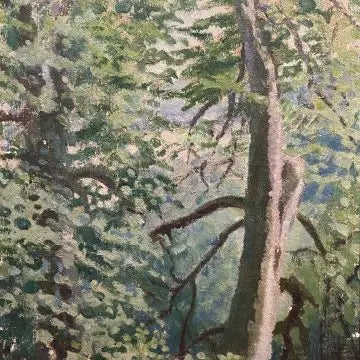

Marjorie Sherlock
Spring in Dorset
Oil on board
Image size: 12 1/2 x 15 1/2 inches (31.75 x 40 cm)
Contemporary-style handmade frame
Exhibitions
1952 Royal Academy of Arts Exhibition, Gallery no. VII, no.429.
This forest scene invites the viewer into a multi-sensory event where the cool, damp shadows of the foliage can almost be felt and the rich bouquet of the forest floor recalled. Here, Sherlock has chosen a somewhat unusual angle and composition, dissecting each trunk and tree form so that only a part can be seen.
Furthermore, as we look into the depths of this space it becomes clear that we are stood gazing down into a valley that is in the distance, behind this wooded area. Indeed, instead of giving us an uninterrupted view of this vista, as perhaps would be expected, our view is deliberately blocked and our focus is directed instead towards the organic forms in the foreground.
Marjorie Sherlock
Marjorie Sherlock was born at Fir Tree Cottage, George Lane, Wanstead, Essex, on 3 February 1891, the elder child of the civil engineer, Henry Sherlock, and his wife, Alice (née Platts), who was born in Benares, India. By 1901, the family was living at ‘The Limes’, 121 Mill Road, Cambridge, and Marjorie received an education locally. In 1918, she entered into marriage with her cousin, Major Wilfrid Barrett, though this proved unsuccessful and they later divorced (he remarrying in 1941). She then continued to live at the family home until the Second World War.
During the First World War, Marjorie Sherlock studied at Westminster Technical Institute under the Camden Town School painters, Walter Sickert and Harold Gilman.
She exhibited at the Royal Academy of Arts from 1917, when she showed a powerful view of the interior of Liverpool Street Station (Government Art Collection) (to which the current etching [202] relates). In time, she would exhibit at the International Society, the New English Art Club, the Royal Society of British Artists, the Society of 207 Graphic Art and the Women’s International Art Club (becoming a member of the last two). She also showed work internationally.
Developing as a printmaker as well as a painter, Sherlock studied etching under Malcolm Osborne at the Royal College of Art in 1925. She published her etchings in four series, the titles of which indicate her love of travel: ‘English Etchings, ‘Egyptian Etchings’ (both 1925), ‘German Etchings’ (1929) and ‘Indian Etchings’ (1932). During this period, she also visited the united States. More admiring of Continental painters than British ones, she furthered her studies, in 1938, by working in Paris under André L’Hôte and André Dunoyer de Segonzac.
During the Second World War, Sherlock moved to East Devon and settled at Oxenways, a Victorian hunting lodge, near Membury and north of Axminster. Of forceful and resourceful character, she established an independent existence on little money by keeping chickens, growing her own vegetables and making her own clothes. However, she continued to work and, in 1948, helped found Axminster Art Society. In her later years, she became a close friend of the artist, Orovida Pissarro, and Pissarro would pay for their occasional travels abroad.
Majorie Sherlock died at Angela Court, Tipton St John (to the west of Axminster), on 2 April 1973. A retrospective exhibition was held at the Maltzahn Gallery, London, in the same year.



